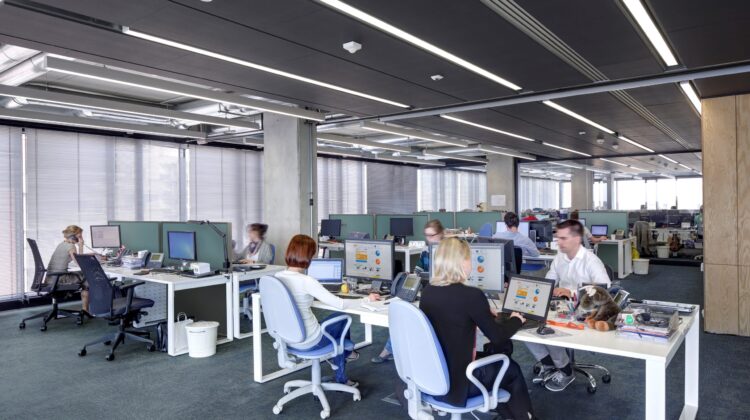
From thunderclaps to crying children: sound waves have a large variety of physical, physiological, and psychological effects on people. These effects, rather than the actual sound wave, affect acoustic comfort. In room-acoustic design, it is often not enough to measure how to achieve the best possible technical parameters. In addition to this, one should always take use and users of a given room to ensure a satisfactory sound environment whether be it for work, learning or healing.
The issue of noise is not new. As early as the time of the Sumerians (3500-1750 BCE), tales were told about the god Enlil, who became so annoyed with the sound of an overcrowded city that he flooded it to drown out the disturbing noise. Fortunately, we have other ways of fighting noise today. However, noise is still one of the main reasons for dissatisfaction, stress and loss of productivity.
ACOUSTIC COMFORT IN THE OFFICE ENVIRONMENT
The psychological impact of noise is more often noticed in rooms where people stay for longer periods of time, like offices, which will be used as an example for this introduction to psychoacoustics. Noise causes irritation elevated stress levels and reduces performance. For employees who work with cognitively challenging tasks, noise is particularly disturbing – and frustrating. There is even evidence that stress from noise affects performance even after the exposure has occurred.
Previously, the efforts for controlling noise in buildings was only focused on physical solutions, such as acoustic ceilings and vertical barriers.
However, the requirements for the workplaces of the 21st century – especially in the connection with open office environments – call for a more holistic approach that includes psychological, physiological as well as physical solutions.
ROOM ACOUSTICS, STRESS AND WELL-BEING
Paige Hodsman of Saint-Gobain Ecophon and Dr. Nigel Oseland
Workplace Unlimited has organized a comprehensive review of the literature published about acoustics in places of work. More than 100 research reports from the 1950s till now were evaluated to create an overview for acousticians, architects, interior designers, and property developers to work together with managers and employees in order to provide healthier, happier and more productive work environments for everyone. Their analysis and recommendations have been published in the report Planning for Psychoacoustics: A Psychological Approach to Resolving Office Noise Distraction. The report presents the theoretical aspects of noise, acoustics and psychoacoustics, and discusses how this knowledge can be used for creating human-centered work environments.
THE FOUR NON-PHYSICAL KEY FACTORS
The Hodsman and Oseland analysis of the research literature identifies four important, non-physical factors that affect stimulation and noise perception, and thus performance:
1. THE NATURE OF THE WORK
Individuals and teams typically perform a number of work activities throughout the day, but generally only has one work environment. According to the principles about activity-based (flexible) work environments, a number of frameworks could be provided that are tailor-made to meet various needs.
Consider:
- The nature of the work
- The complexity of the tasks
- Whether multi-tasking is required
- Whether the task requires silence.
2. THE CONTEXT OF THE NOISE
The perception of noise is influenced by the relation to the noise source. In general, we tend to be less disturbed by sound sources that we understand and feel comfortable with. This may be conversations that is relevant to the working group, or conversations among close colleagues.
Consider:
- The attitude of the employees creating the noise
- Whether the noise is experienced as necessary.
3. THE SENSE OF CONTROL AND PREDICTABILITY
It is crucial to the well-being of the employees that they have a sense of being able to control their sound environment.
It is in many cases not to be recommended to leave the fight against noise to employees only. Especially not in large office landscapes. People in need of noise reduction often also tend to avoid confrontations. An official noise policy is therefore recommended. It may contain descriptions of acceptable behavior and recommend acknowledged signals, such as small ‘I-am-busy-flags’ on the desktop or the use of headphones.
Consider:
- Whether the noise sources are sporadic or stable
- Whether the noise is predictable
- Whether the persons who are exposed to noise have control of the noise or can avoid or reduce it.
4. PERSONALITY AND TEMPERAMENT
There is plenty of evidence that the most productive teams have a rich mix of personality types. Nevertheless, most workplaces are more suitable for the extrovert types due to the prevalence of open office landscapes. Psychological profiling is often used for determining whether a person has the appropriate personality and attitude to join an organisation or a team, but it could also be used for putting people together who prefer and function better in certain acoustic environments. An even better opportunity is to create suitable spaces for different types of personality and to allow employees to choose where they want to work.
Consider:
- Who are the most sensitive to noise?
- Who seeks stimulation? Who seeks solitude?
- What is the effect in the room when the mood changes?
A special thank you to Paige Hodsman & Nigel Oseland for their work around psychoacoustics

